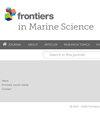在不列颠哥伦比亚省中部海岸,浮游植物群落组成与峡湾到大陆架梯度的环境驱动因素有关
IF 3
2区 生物学
Q1 MARINE & FRESHWATER BIOLOGY
引用次数: 0
摘要
快速的环境变化正在改变沿海浮游植物的动态,从而改变沿海海洋食物网的生产力。不幸的是,浮游植物群落数据的缺乏阻碍了对东北太平洋沿海等生态生产力地区未来状况的预测。为了填补这一空白,本研究对2018年至2020年加拿大不列颠哥伦比亚省中部海岸峡湾、海峡和大陆架站样带的浮游植物群落进行了研究。每个月采集样本,进行基于显微镜的分类和基于色素的浮游植物组成(即CHEMTAX和大小分级叶绿素)。相关分析是浮游植物生物量变化的驱动因素,层次聚类和冗余分析是浮游植物生物量变化趋势的驱动因素。春季开花形成了每个站年生物量的峰值,而峡湾站较早的开花表明了对冬季风条件的遮蔽作用。后来,海峡车站的春花盛开,恰逢季节性的风减少和阳光增加。在6个衍生的组成簇中,3个代表所有站点的鞭毛虫主导条件;2个代表低生物量冬季条件,第三个代表养分充足条件下的中度生物量春季和秋季华。剩下的三个簇以硅藻为主,并且跨越了大部分生长季节。第一个硅藻群代表马里诺骨骼肌为主的样本,许多来自2020年,在中等营养和高分层和淡水排放条件下观察到。第二种模式代表所有站点的高硅藻丰富度春季开花条件与养分枯竭有关。最后,第三个包括2018年和2019年夏季大陆架样本,显示在高盐度和高温度的地表水下有害的扶桑根和假扶桑根开花。这些结果强调了东北太平洋沿海浮游植物群落对淡水、温度和风动力变化的高度时空变异性和敏感性,具有潜在的深远生态系统意义。本文章由计算机程序翻译,如有差异,请以英文原文为准。
Phytoplankton community composition links to environmental drivers across a fjord to shelf gradient on the central coast of British Columbia
Rapid environmental change is altering coastal phytoplankton dynamics and, thereby the productivity of coastal marine food webs. Unfortunately, a paucity of phytoplankton community data hinders the prediction of future conditions in ecologically productive regions such as the coastal northeast Pacific. To help fill this gap, this study characterized phytoplankton communities from 2018 to 2020 across a fjord, channel and shelf station transect on the central coast of British Columbia, Canada. Monthly samples were collected for microscopy-based taxonomy and pigment-based phytoplankton composition (i.e. CHEMTAX and size-fractionated chlorophyll). Correlation analysis was used to investigate drivers of phytoplankton biomass and hierarchical clustering and redundancy analysis highlighted drivers of compositional trends. Spring blooms formed the peak of annual biomass at each station and earlier blooms at the fjord station suggested a sheltering effect from winter wind conditions. Later spring blooms at the channel station coincided with seasonal wind reductions and increased sunlight. Of the six derived compositional clusters, three represented flagellate dominated conditions at all stations: two represented low biomass winter conditions and the third, moderate biomass spring and autumn blooms occurring under nutrient replete conditions. The remaining three clusters were diatom-dominated and spanned much of the growing season. The first diatom cluster represented Skeletonema marinoi dominated samples, many from 2020, observed under moderate nutrient and high stratification and freshwater discharge conditions. The second represented high diatom richness spring bloom conditions at all stations that were associated with nutrient depletion. Finally, the third included 2018 and 2019 summer shelf samples showing harmful Rhizosolenia setigera and Pseudo-nitzschia seriata blooms under high surface water salinity and temperature. These results highlight high spatial-temporal variability and sensitivity of coastal northeast Pacific phytoplankton communities to altered freshwater, temperature and wind dynamics with potential for profound ecosystem level implications.
求助全文
通过发布文献求助,成功后即可免费获取论文全文。
去求助
来源期刊

Frontiers in Marine Science
Agricultural and Biological Sciences-Aquatic Science
CiteScore
5.10
自引率
16.20%
发文量
2443
审稿时长
14 weeks
期刊介绍:
Frontiers in Marine Science publishes rigorously peer-reviewed research that advances our understanding of all aspects of the environment, biology, ecosystem functioning and human interactions with the oceans. Field Chief Editor Carlos M. Duarte at King Abdullah University of Science and Technology Thuwal is supported by an outstanding Editorial Board of international researchers. This multidisciplinary open-access journal is at the forefront of disseminating and communicating scientific knowledge and impactful discoveries to researchers, academics, policy makers and the public worldwide.
With the human population predicted to reach 9 billion people by 2050, it is clear that traditional land resources will not suffice to meet the demand for food or energy, required to support high-quality livelihoods. As a result, the oceans are emerging as a source of untapped assets, with new innovative industries, such as aquaculture, marine biotechnology, marine energy and deep-sea mining growing rapidly under a new era characterized by rapid growth of a blue, ocean-based economy. The sustainability of the blue economy is closely dependent on our knowledge about how to mitigate the impacts of the multiple pressures on the ocean ecosystem associated with the increased scale and diversification of industry operations in the ocean and global human pressures on the environment. Therefore, Frontiers in Marine Science particularly welcomes the communication of research outcomes addressing ocean-based solutions for the emerging challenges, including improved forecasting and observational capacities, understanding biodiversity and ecosystem problems, locally and globally, effective management strategies to maintain ocean health, and an improved capacity to sustainably derive resources from the oceans.
 求助内容:
求助内容: 应助结果提醒方式:
应助结果提醒方式:


